High Shear Mixers | FRANLI Mixers
High Shear Mixer
High shear mixers are industrial machines that are used for mixing, blending, emulsifying, dispersing, and homogenizing various materials. They are commonly used in industries such as food processing, cosmetics, pharmaceuticals, and chemical manufacturing.
Details of High Shear Mixer
- Suitable for the material before the process
- Small energy consumption
- Large capacity
- Certain self-suction and low lift transport function
Application: Paint, Adhesive, Battery, Pharmaceutical industry, Cosmetic
A high shear mixer, also known as a high speed disperser or high speed mixer, is a machine that uses high-speed rotating elements to impart intense shearing forces on the materials being processed. The key components of a high shear mixer include a stationary container or vessel, a rotating shaft, and shear blades or elements attached to the shaft.
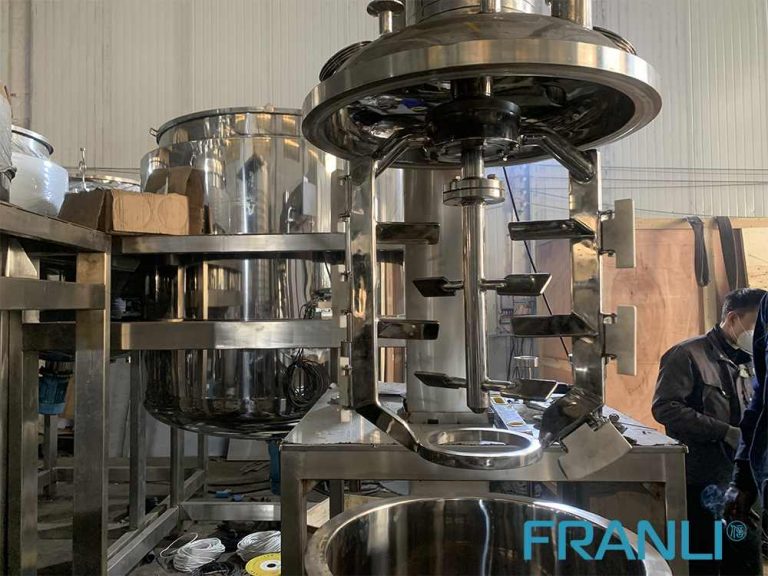
During operation, the materials to be mixed are loaded into the stationary vessel. The rotating shaft spins at very high speeds, typically between 3,000 to 30,000 RPM. The high-speed rotation of the shear blades creates intense shearing forces that break down, disperse and homogenize the materials. This intense shearing action allows high shear mixers to efficiently mix materials that are difficult to blend using conventional low shear mixers.
Working Principle of High Shear Mixing
The working principle of high shear mixing involves the generation of intense shearing forces through high-speed rotation. As the shear blades rotate at high RPM inside the stationary vessel, they impart shearing forces on the materials. These shearing forces break down the materials into very small particles or droplets through various mechanisms:
– Impact Shearing: The high-speed rotation of the blades causes them to impact the materials with great force, breaking them down into smaller pieces through impact shearing.
– Fluid Shearing: The spinning blades create turbulence and fluid shearing stresses in the materials. This fluid shearing helps to break down and disperse the materials into a uniform mixture or emulsion.
– Cavitation: In some high shear mixers, the rapid spinning of the blades near the speed of sound creates vacuum pockets or cavitation in the materials. The sudden collapse of these cavitation bubbles generates huge shearing forces, further facilitating the mixing process.
– Dispersion: The intense shearing breaks down agglomerates and disperses particles uniformly throughout the mixture. It prevents the re-agglomeration of particles.
– Emulsification: Oil and water mixtures can be efficiently emulsified into a homogeneous state due to the intense shearing forces generated.
– Degassing: Entrapped air or gas bubbles are removed from the mixture through the cavitation effect of high shear mixing.
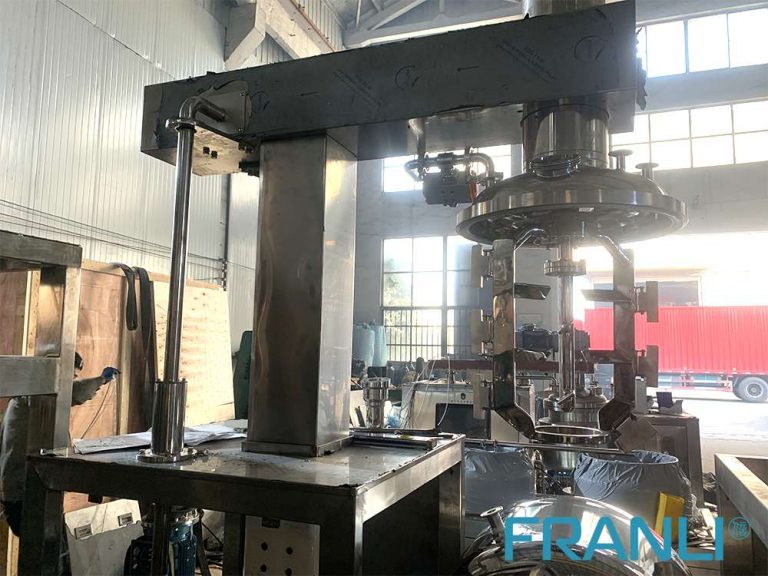
Applications of High Shear Mixers
Due to their ability to efficiently mix very difficult materials, high shear mixers have applications across many industries:
1.Food Processing Industry
– Mayonnaise, salad dressings and sauces preparation
– Ice cream, frozen desserts, and dairy products manufacturing
– Bakery products like cake mixes and batters
– Beverage mixing and blending
2. Pharmaceutical Industry
– Manufacture of ointments, creams and gels
– Preparation of suspensions, emulsions and parenteral formulations
– Dispersing of powders into liquid carriers
3. Cosmetics Industry
– Manufacture of lotions, creams, gels and other personal care products
– Production of makeup, lipsticks and other color cosmetics
4. Chemical Industry
– Paints, coatings and ink manufacturing
– Pigment dispersion and grinding
– Polymer synthesis and compounding
– Petroleum products blending
5. Other Applications
– Adhesives and sealants preparation
– Mining and mineral processing
– Wastewater treatment
– Biofuel production
Benefits of Using High Shear Mixers
There are several advantages and benefits of using high shear mixers in industrial applications:
– Efficient mixing – They can mix materials in just a few seconds that would otherwise take hours using low shear mixers.
– Uniform mixtures – The intense shearing action ensures uniform dispersion and prevents re-agglomeration.
– Small particle sizes – Materials can be broken down into very fine particles ranging from 1-100 microns.
– Excellent heat transfer – Frictional heat generated during mixing helps processes like melting and dissolution.
– Versatile – Suitable for a wide range of applications involving liquids, pastes, slurries, and dry powders.
– Compact design – Occupy less floor space compared to conventional mixers.
– Closed system – Containment of dust or contamination during mixing.
– Easy to clean – Simple designs allow for quick cleaning and changeovers.
– Automation compatible – Can be integrated into automated production lines.
– Energy efficient – Require less energy compared to conventional mixing methods.
Types of High Shear Mixers
There are different types of high shear mixers available based on the configuration of the mixing elements. Some common types include:
– Single-Stage Mixers: Simple design with one set of shear blades. Used for less viscous materials.
– Two-Stage Mixers: Contains two sets of blades for higher shear rates. Suitable for very viscous mixtures.
– Ribbon Mixers: Blades attached to the shaft in the form of ribbons for better material folding action.
– Dual-Shaft Mixers: Two counter-rotating shafts with intermeshing blades for maximum shearing.
– Inline/Continuous Mixers: For continuous high-speed mixing in production lines.
– Sanitary Mixers: CIP/SIP-capable designs for food/pharma applications.
– Aseptic Mixers: Hermetically sealed for sterile mixing in sensitive industries.
– Dispersing Mixers: Specialized designs for efficient particle size reduction.
– Media Mixers: Can add grinding media like beads for dispersion applications.
– Vacuum Mixers: Capable of mixing under vacuum for degassing and moisture removal.
The key components of a high shear mixer include:
– Stationary Vessel: Made of steel, alloy, or plastic to hold the materials being mixed.
– Drive Motor: Provides rotational power input, usually 3-phase AC motor.
– Gearbox: Transmits torque from motor to mixing shaft and regulates speed.
– Shaft: Holds the shear blades/elements and transmits rotational motion.
– Blades: Attached to the shaft in various configurations to impart shearing.
– Seals: Prevent leakage and contain dust/contamination.
– Support Frame: Holds and supports the entire assembly.
– Controls: PLC/HMI for process control, speed regulation, and safety.
– Accessories: Agitators, scrapers, sensors, sanitary fittings, etc.
Parameters for High Shear Mixing
Key parameters to consider for high shear mixing include:
– Mixer Type: Based on application and material properties.
– Shaft Speed: Typically 3,000-30,000 RPM for high shear action.
– Mixing Time: A few seconds to several minutes based on formulation.
– Batch/Continuous: Based on production requirements.
– Vessel Size: Depends on batch size and scale of production.
– Blade Configuration: Selected for optimal shearing and flow patterns.
– Temperature Control: Jacketed vessels for heating/cooling as required.
– Instrumentation: Sensors for load, speed, temperature, and flow monitoring.
– Safety Systems: Interlocks, guards, and emergency stops for personnel safety.
Welcome to send inquiry to us and let’s make a win win business together !
Guidelines For High Shear Mixer
The mixing device of the high shear mixer is a rotor with four blades, which rotates at a high speed in a stationary stator to complete the entire stirring and mixing process.
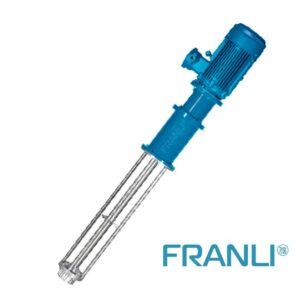
High Shear Mixers: A Guide to Applications in the Cosmetics Industry
A high shear mixer is one of the most versatile pieces of equipment used in the cosmetic industry. It is designed to mix, emulsify, disperse, and homogenize a wide range of cosmetic products.

What is a High Shear Emulsifier?
High shear emulsifiers are innovative and efficient machines that are used in various industries for the purpose of emulsification, homogenization, and particle size reduction.
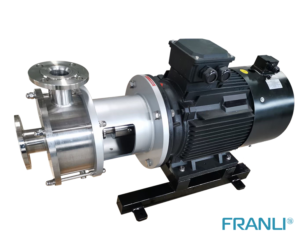
What is an Inline Homogenizer?
An inline homogenizer is a machine that is used to mix and blend different substances together to create a uniform mixture. It is an essential tool in the manufacturing industry, particularly in the production of food, pharmaceuticals, and cosmetics.
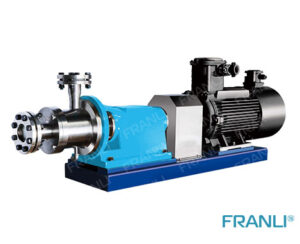
What is an Inline Emulsifier?
An inline emulsifier is a type of high shear mixer that is designed to create a stable emulsion by breaking down the droplets of one liquid into smaller droplets and dispersing them throughout the other liquid.

High Shear Mixer: An Essential Tool for Efficient Mixing
A high shear mixer is a device that is used to mix, emulsify, disperse, and homogenize materials. It is a versatile tool that can be used in a variety of industries such as food, pharmaceuticals, cosmetics, and chemical manufacturing.

High Shear Mixers: Experimental & Production
High-shear mixers are primarily used in industry to produce standard mixtures of ingredients that do not mix naturally. When the total fluid of the material is composed of two or more liquids, after the work of the high-shear mixer, an emulsion is finally formed.

